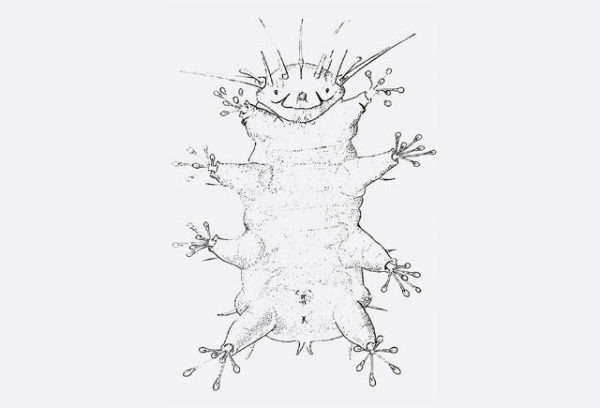Published in the Ocean Watch column, Honolulu Star-Advertiser © Susan Scott
November 18, 2017
I’ve been a “Star Trek” fan from the first show in 1966 to this week when I shouted at the TV, “Hey, that’s a tardigrade!” The writers of the new series, “Star Trek Discovery,” won my heart by incorporating in the plot an adorable animal called a tardigrade, otherwise known as a water bear.
 A drawing of a water bear, or tardigrade appeared
A drawing of a water bear, or tardigrade appeared
in the scientific journal Acta Zoologica in 1981.
Courtesy Acta Zoologica.
More than 1,000 species of water bears have been named, but researchers estimate there may be as many as 100,000. The reason so many of the little cuties remain to be discovered is that nearly all are microscopic. Water bears are typically 100 to 150 microns long, one micron being one one-thousandth of a millimeter. (One millimeter is the smallest we humans can see with the naked eye.) The giants of the tardigrades are 1.5 mm long.
Although they can’t swim, tardigrades are aquatic, living wherever tiny drops of fresh or salt water form. These minuscule teddy bears are found everywhere worldwide, from hot springs and glaciers to ocean floors, beaches and mountaintops, including those of Hawaii.
If a tardigrade’s film of water evaporates, the plump creature dries up and enters a state called cryptobiosis. The creature’s metabolism slows to nearly undetectable levels, increasing its normal life span of one year to 100 years or more.
In this state, water bears have survived temperatures as high as 300 degrees Fahrenheit and as low as minus 456 degrees. The animals have also lived through vacuums, intense radiation and zero oxygen. (Researchers love testing these potential space travelers.)
Two of my invertebrate zoology textbooks use the terms enchanting, endearing and cute in their introductions to water bears. The tiny teddies trudge around on four pairs of legs. The name “tardigrade” comes from Latin “tardus,” meaning slow, and “gradus,” meaning step.
A few tardigrades are carnivores, but most are plodding vegetarians, never in a hurry to run toward or away from anything.
The teeth and claws of some water bear species look fearsome. Most mouths are telescoping cones bearing needlelike spines called stylets that pierce plants’ cell walls. The contracting legs are tipped with either talons or suction cup toes, depending on the creature’s habitat.
We Trekkies must pay to watch “Star Trek Discovery” on CBS All Access. So worth it! I came home from Australia to find in an early episode a tardigrade named Ripper the size of a grizzly bear with claws and stylet teeth to match. The writers clearly boned up on water bear biology and, except for mass, got it right.
Although the story at first portrays Ripper as a flesh-shredding monster, the sweet-natured tardigrade turns out to be simply hungry and scared. The crew feeds Ripper and sets it free. Of course. It’s “Star Trek.”
Live long and prosper.